 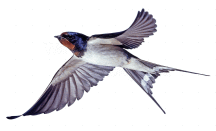 According to the taxonomy of living things, the phylum chordata (animals with backbones) is divided into five classes: fish, amphibians, reptiles, mammals and birds. Birds are warm-blooded vertebrates and are the only animals with feathers. Although all birds have wings, a few species can't fly. Many can run, jump, swim, and dive. Some, like penguins, have lost the ability to fly, but retained their wings. Birds are found worldwide and in all habitats. The largest is the nine-foot-tall ostrich. The smallest is the two-inch-long bee hummingbird. A bird's wings are modified forelimbs, a trait shared with bats. Birds lay hard-shelled eggs. They have keen vision, the major sense they rely on for information about the environment. Their sense of smell is poor. Among flying birds, the wandering albatross has the greatest wingspan, up to 3.5 metres, and the trumpeter swan the greatest weight, 17 kg. In the largest flying birds, part of the bone is replaced by air cavities because the maximum size attainable by flying birds is limited by the fact that wing area varies as the square of linear proportions, and weight or volume as the cube. Everything about the anatomy of a bird reflects its ability to fly. The wings are shaped to create lift; the leading edge is thicker than the back edge, and they are covered in feathers. The bones and muscles of the wing are also highly specialized. The main bone, the humerus, is hollow instead of solid. It also connects to the bird’s air sac system, which, in turn, connects to its lungs. The powerful flight muscles of the shoulder attach to the keel, a special ridge of bone that runs down the center of the wide sternum, or breastbone. The tail feathers are used for steering. Birds have a unique digestive system that allows them to eat when they can and digest later. They use their beaks to grab and swallow food. Even the way a bird reproduces is related to flight. Instead of carrying the weight of developing young inside their bodies, they lay eggs and incubate them in a nest. Let's look at some special examples of birds ... The Smallest Bird 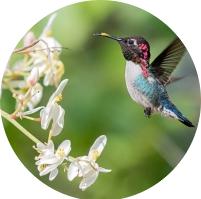
The Bee Hummingbird, which is found only in Cuba, is tiny even for a hummingbird. It measures a mere 5.7 centimetres long. Bee Hummingbirds are indeed often mistaken for bees. These tiny birds weigh less than two grams — less than a dime. That's half the weight of a normal hummingbird. The female Bee Hummingbird builds a nest barely an inch across; her eggs are about the size of a coffee bean. The Largest Bird 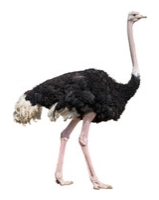 The ostrich, native to Africa, is the largest and heaviest bird in the world. Ostriches can reach up to 2.7 metres in height and weigh around 100-160 kilograms. They also lay the largest eggs in the world, averaging around 15 cm long and weighing up to 1.5 kg.
The ostrich, native to Africa, is the largest and heaviest bird in the world. Ostriches can reach up to 2.7 metres in height and weigh around 100-160 kilograms. They also lay the largest eggs in the world, averaging around 15 cm long and weighing up to 1.5 kg. Ostriches are herbivorous ... they live mostly on plant matter, like grass and flower seed heads. Occasionally in the wild they will also eat locusts and animal remains left by predators. The Fastest Bird 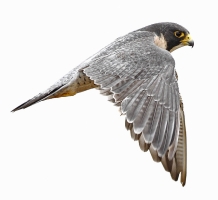 The bird that can achieve the greatest airspeed is the peregrine falcon, able to exceed 320 km/h as it dives to capture prey. In fact, this falcon is the fastest living creaure!
The bird that can achieve the greatest airspeed is the peregrine falcon, able to exceed 320 km/h as it dives to capture prey. In fact, this falcon is the fastest living creaure! Peregrine falcons are large predatory raptors with a 1 metre wingspan. The falcon's strong, sharp talons allow it to capture other birds, even while in flight. They are found on every continent except Antarctica. Peregrine falcons can travel long distances, sometimes between continents, to get from their wintering grounds to their breeding grounds. The Highest Flying Bird 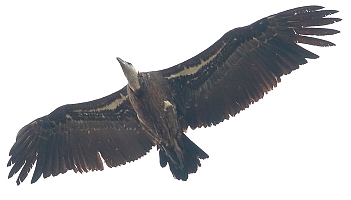 A Rüppell's Griffon Vulture holds the record for the highest flying bird, reaching heights of 11 kilometres.
Rüppell's vulture is distributed throughout East Africa, where it inhabits grasslands and woodlands.
A Rüppell's Griffon Vulture holds the record for the highest flying bird, reaching heights of 11 kilometres.
Rüppell's vulture is distributed throughout East Africa, where it inhabits grasslands and woodlands. Adults are up to a metre long, with a wingspan of up to 2.6 m, and a weight as much as 9 kg. Like other vultures, the head has no feathers, probably an adaptation because of its tendency to stick its head inside prey when eating. The Most Dangerous Bird 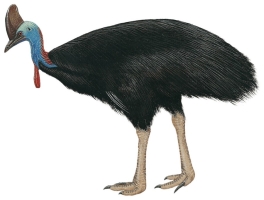 The cassowary is a large, flightless bird native to Australia, and is considered the most dangerous bird in the world! Each 3-toed foot has a dagger-like claw on the inner toe that is up to 10 centimetres long. The cassowary can slice open any predator or potential threat with a single swift kick. In addition, powerful legs help the cassowary run up to 50 kilometres per hour through dense forest underbrush. A cassowary can also jump nearly 2 meters straight up into the air, and it's a good swimmer too.
The cassowary is a large, flightless bird native to Australia, and is considered the most dangerous bird in the world! Each 3-toed foot has a dagger-like claw on the inner toe that is up to 10 centimetres long. The cassowary can slice open any predator or potential threat with a single swift kick. In addition, powerful legs help the cassowary run up to 50 kilometres per hour through dense forest underbrush. A cassowary can also jump nearly 2 meters straight up into the air, and it's a good swimmer too.
The Loudest Bird 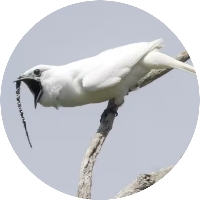 The white bellbird, a fruit-eating, treetop bird that lives in the northern mountains of the Amazon rainforest, is the world’s loudest bird, with the male producing vocalizations of up to 125.4 decibels, which is the pain threshold for sounds, and about as loud as a large aircraft engine at take-off. The amazing call is used to court females, along with snow-white plumage and a long, fleshy black, worm-like ornament near the beak.
The white bellbird, a fruit-eating, treetop bird that lives in the northern mountains of the Amazon rainforest, is the world’s loudest bird, with the male producing vocalizations of up to 125.4 decibels, which is the pain threshold for sounds, and about as loud as a large aircraft engine at take-off. The amazing call is used to court females, along with snow-white plumage and a long, fleshy black, worm-like ornament near the beak.In case you're wondering, the goal of the loud call isn't to attract females from far away — the males scream while twirling right in front of them! The Longest Living Bird 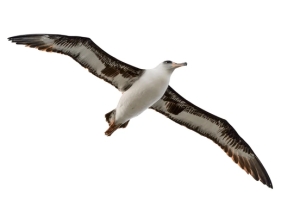 The bird that lives the longest in the wild is thought to be the albatross, a large seabird that ranges across the North Pacific.
The bird that lives the longest in the wild is thought to be the albatross, a large seabird that ranges across the North Pacific. The Laysan albatross, in particular, is known to have a lifespan of around 60 years. This bird can glide over the open ocean for hours at a time without a single flap of its long, narrow wings, sailing hundreds of miles a day on their impressive six-foot span. The majority of Laysan Albatrosses breed in the Hawaiian Islands The Most Intelligent Bird 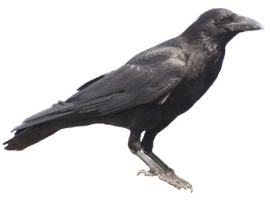 Many researchers believe that the most intelligent birds are found in the Corvid family (ravens, crows, magpies and jays). These social birds show advanced problem-solving skills, in the lab and in the wild.
Many researchers believe that the most intelligent birds are found in the Corvid family (ravens, crows, magpies and jays). These social birds show advanced problem-solving skills, in the lab and in the wild.The smartest of these, the common crow, lives in open areas, farmland, the edges of woods, and parks throughout North America. Crows are omnivorous, eating just about anything. They feed on insects, spiders, small birds, eggs from other birds' nests, seeds, rodents, and the flesh of dead animals, as well as garbage. The Farthest Traveling Bird  The Arctic Tern has by far the longest migration known in the animal kingdom. This medium-sized bird travels 90,000 km from pole to pole every year — from Greenland in the north to the Weddell Sea off Antarctica in the south.
The Arctic Tern has by far the longest migration known in the animal kingdom. This medium-sized bird travels 90,000 km from pole to pole every year — from Greenland in the north to the Weddell Sea off Antarctica in the south. Arctic Terns are social birds, foraging in groups and nesting on the ground in colonies. Arctic Terns can live for decades, but they usually do not start breeding until they are 3 or 4 years old. The Bird Best Adapted to the Cold  Some kinds of penguins spend most of their lives in water, but they still lay their eggs and raise their chicks on land. All 17 species of penguins live south of the equator. many in very cold regions.
Some kinds of penguins spend most of their lives in water, but they still lay their eggs and raise their chicks on land. All 17 species of penguins live south of the equator. many in very cold regions. Penguins have a layer of blubber, or fat, under the skin to help keep them warm. Seven kinds of penguins visit Antarctica, but only two species, the Adelie and Emperor penguins, breed exclusively there. Penguins are also the only birds that migrate by swimming. |